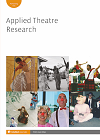
Full text loading...
 , Manuel Muñoz-Bellerín2
, Manuel Muñoz-Bellerín2 , Purificación Pérez-García1
, Purificación Pérez-García1
This article addresses the potential of applied theatre to build spaces of visibility and recognition for homeless people. It describes the logics, achievements and challenges of Teatro de la Inclusión and Fuera de la Campana, two theatrical experiences coordinated by the authors in southern Spain. These cases have been investigated and documented through ethnographic procedures that have included participant observation and in-depth interviews with the group’s participants, among other data-collection techniques. Through the voices of their protagonists, the authors critically discuss the perceived benefits of the experiences by studying their potential for recognition and the artistic teaching methodologies put into play. They also analyse the convergences and divergences in the aesthetic-political conceptions of each of the groups and their consequences in their respective contexts.

Article metrics loading...

Full text loading...
References


Data & Media loading...

Publication Date:
https://doi.org/10.1386/atr_00053_1 Published content will be available immediately after check-out or when it is released in case of a pre-order. Please make sure to be logged in to see all available purchase options.